|
RV Electrical Tutorial
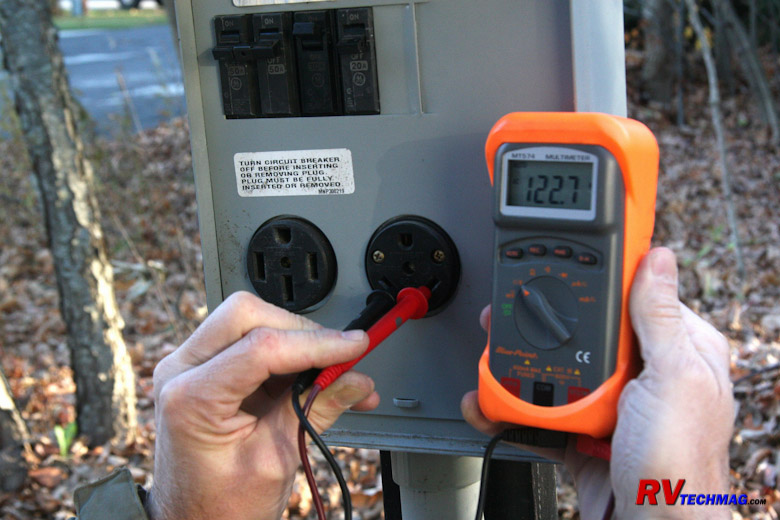
Chapter 12 - Energy Management
Energy Management is simple - you just need to make sure that you don't use any more power than is available.
Battery power is finite. Eventually it'll run out. By minimizing how many lights are on and the time they are on, battery
life can be extended. Eventually you'll need to recharge them, either by driving the coach or by running the generator. Adding
extra batteries can extend that runtime as can the addition of solar panels. If you are plugged into shore power this isn't an
issue because your converter or inverter/charger will keep them charged while you use them.
AC power is a bit different. Unlike battery power, there is no reserve to draw from. You are limited to the
total current capacity of your shore power pedestal or your generator capacity. Generators are generally sized for that
particular coach so you should be able to run whatever loads you need to operate without exceeding the generator's capacity.
Of course there are exceptions where an undersized generator was specified in that particular coach rather than choosing the
optional generator but those are the exception, not the rule.
Shore power pedestals vary in size. If you are running a small 20 amp cord to your RV from someone's home you'll
be very limited as to what you can run. Battery chargers vary in current draw as to how many battery amps they are outputting.
A battery charger that is outputting a full 100 amp bulk charge at 12 volts will be drawing 10 amps of 120 volt AC power. That
can take up one half of your 20 amp circuit, which doesn't leave a whole lot left. Many inverter/chargers have a setting on
the remote control panel to define the shore power service. If you define the shore power at a lower level, say 20 amps, then
it will limit the 120 volt power that they battery charger uses so that you can have more left to run other 120 volt items. You
will need to manually set this once you are plugged into a smaller shore power pedestal.
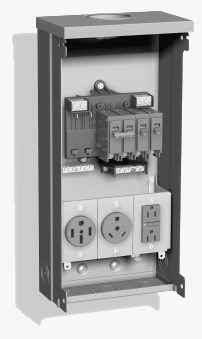
RV Pedestal
In the above image we can see three receptacles. This is a typical 50 amp pedestal which features a 50 amp,
30 amp, and 20 amp outlets. This pedestal allows virtually any type of RV to be serviced with power. The 50 amp outlet is a
120/240 volt split-phase outlet, capable of 12,000 watts of total power. If you have an RV with 50 amp service you should have
no problems powering your RV's electrical appliances when plugged into a 50 amp outlet. Older pedestals may only be configured
with a 30 amp outlet however. This is a single pole 120 volt feed, capable of 3,600 watts of total power. You can adapt your
50 amp coach to this 30 amp outlet via a dogbone adaptor but you will be severely limited in just how much stuff you can run in
your RV. If the battery charger is pulling 5 amps and your two air conditioners are pulling 12 amps each you'll be drawing a
total of 29 amps. All it takes is for the electric water heater element to kick in or someone turning on the microwave and you'll
trip the pedestal breaker and you'll be making a trip out to the pedestal to reset it, which of course always happens when it's
raining. 
Manual energy management entails turning off some loads so that you can turn on others. If you really need to
get hot water it would be best to use the propane burner instead of electric if it's hot out. If you need to use the microwave
for a bit then you'll have to shut down one of the air conditioners so that amperage can be used by the microwave temporarily.
Eventually this gets to be tiring and you'll either find places to stay at that only have 50 amp service or you'll wish you had
an automatic energy system.
Automatic Energy Management Systems:
Automatic Energy Management Systems (EMS) automatically perform the circuit switching procedures for you. Do not
confuse a true EMS system with surge protection. Some name brand surge protectors use the term EMS in their models and descriptions.
In a way, this is true because they do more than stop surges. They also protect from low or high voltage but they are still part of
the "surge protectors" category. EMS systems do not consider voltage levels. They only monitor the amperage draw and perform
shedding of various circuits to keep the total power consumption beneath the pedestal breaker rating.
|
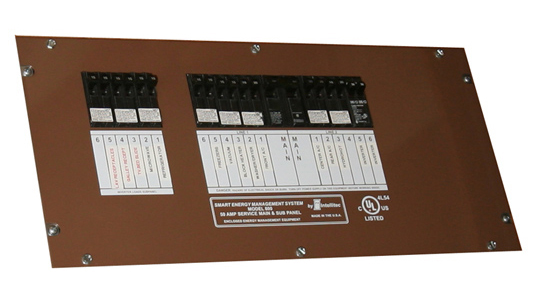
|
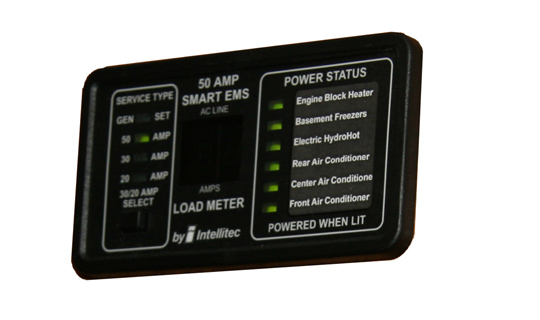
|
|
Intellitec EMS800 Panel
|
Intellitec Remote Display
|
The most popular Energy Management System of years back was made by Intellitec.
The Intellitec system consists of a custom breaker panel which has four 120 volt relays and two low voltage relays. These relays are controlled
by a proprietary electronic module that turns these relays on and off as needed. The board senses the power that is coming into the breaker
panel. If it sees 240 volts across L1 and L2 it knows that it is a 50 amp feed and it performs no energy management tasks. If it sees 12 volts
at the terminal that is connected to the generator's hourmeter it knows that the generator is running. In this case it will display the amperage
on the remote display panel but will not perform any load shedding tasks. If the generator run signal is not present and 240 volts is not present
it will know that you are on a 120 volt single pole shore power feed. It will default to a 30 amp setting but you can change it to 20 amps if you
need to by pushing that button on the remote display panel. In this mode it will display the amps being used and shed any circuits that need to be
shed in order to remain underneath the 30 amp (or 20 amp if selected) limit of the pedestal breaker. The loads are shed according to a
pre-determined load shedding order, whereby the least critical circuits are shed first. A complete manual for the EMS800 is available at
EMS800_SvcManual.pdf. The biggest drawback to this system is that the breaker panel is quite large at
over 20" in width, which makes it difficult, if not impossible, to install when retrofitting a coach without an EMS. This system has since been
discontinued and RV manufacturers are now goign with a newer, more technologically advanaced unit by
replaced by newer units by Precision Circuits, Inc.
Assuming that you want to run two air conditioners (at 12 amps each), the electric water heater (at 10 amps), and your
battery charger (4 amps in float mode). That's a total of 38 amps, which won't work on a 30 amp service. We've already switched the
refrigerator over to propane so that's out of the equation. The EMS will shed the first available load, which is the water heater so that
everything else can run. You'll then be drawing 28 amps. When the thermostat kicks out one air conditioner the load will be reduced to 16
amps so power to the hot water heater will now be restored and the new load will be 26 amps. If someone turns on the microwave and needs
another 11 amps, the total draw would be 37 amps so the EMS will shed the next item on the list so now the water heater and one air
conditioner will be shed. When the microwave is finished the next priority level circuit will be restored, which in this case is the air
conditioner. By doing this the EMS prevents the pedestal breaker from tripping by limiting the total current.
|

|
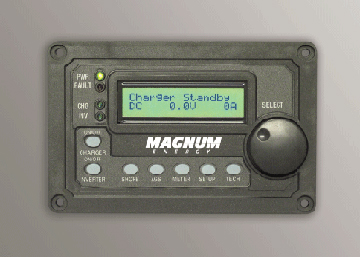
|

|

|
Magnum Inverter
|
Inverter Remote Display
|
EMS Remote Display
|
EMS Breaker Box
|
A more recent entry into the energy management field is an EMS by
Precision Circuits, Inc. This unit operates in similar
fashion to the Intellitec system except it takes it one step farther. It actually interfaces with the inverter and will trigger the inverter
so that it powers its output circuits rather than passing through shore power. This way when someone operates the microwave the inverter
will power it rather than shedding a circuit. Should this continue for a long time the EMS will stop the inverter to prevent running the
batteries too low and will shed circuits like a traditional EMS. This offers the benefit of not having to shut down your air conditioner on
a hot day if other loads are going in and out. In order for this feature to function the PCI EMS must be connected to a Magnum inverter.
A number of manufacturers are now using thi8s more sophisticated system. An additional remote display panel is required - one for the inverter and
one for the EMS.
In the next chapter we'll talk about low voltage and surge protection.
Index
|



